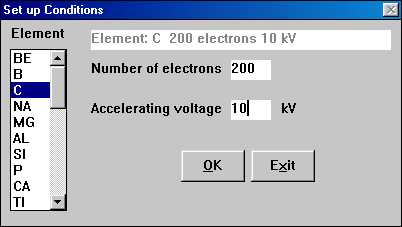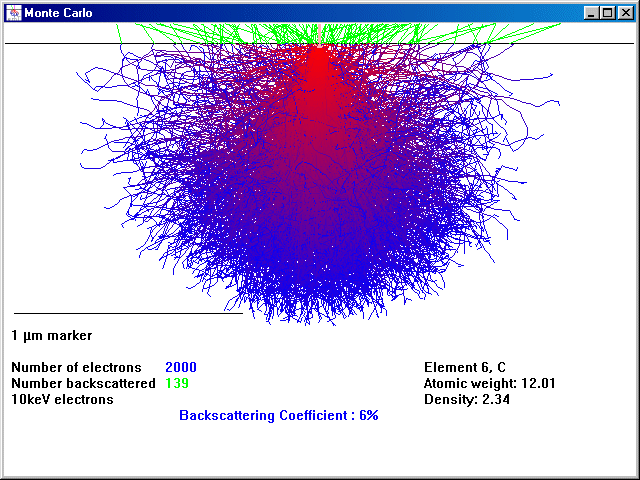
Part of the emTUTOR package
- a tutorial system for electron microscopy
Monte plots electron-solid interactions, showing the electron trajectories and energies in a bulk sample. Random numbers are used to simulate the chance inherent in electron scattering - hence the term Monte Carlo. This implementation - to the best of our knowledge the fastest in the world - adds the trajectories of the backscattered electrons that escape from the sample. This was developed and is supplied as a standard part of the emTUTOR package but since it is based on public-domain algorithms developed by David Joy we have always made it available for free download. It runs under any flavour of Windows from 3.1 onward.

At the opening window you need to select an element for your specimen - 30 are available, covering most likely SEM specimens and a few unlikely ones, as well as the accelerating voltage (kV), and the number of electrons. The program is fast so donít be afraid to select a large number of electrons.

One electron at a time is followed through its path into the specimen. You will see the number of interactions it has, until it either comes to rest or escapes again as a backscattered electron. A running tally of the total number of electrons, and the number backscattered, is kept. A scale bar shows you the size of the volume involved. The electrons progressively change colour as they lose energy.
At the end of the run you will be shown the backscattered electron coefficient (that is, the proportion of the total electrons which escaped) and the mean energy of the backscattered electrons. If you run the calculation for a reasonably large number of electrons (at least 1000) you should get a pretty accurate figure for the BS coefficient, and a reasonable representation of the irradiated volume. As a reasonable approximation, the X-ray spectrum will derive from the whole of this volume, while backscattered electrons will come from the upper half. Secondary electrons will only come from the surface layers, but this does not mean that the SE signal will derive only from the point at which the beam hits, since the BS electrons can also give rise to secondaries as they escape.
Downloading Monte
Monte.exe is a small program (under 40k) which will be quick to download even over a slow line. It needs no ancillary files, and no special installation. Just save the file to a folder of your choice on your hard disk. Drag the Monte icon on to the desktop to a create a link to it. You can then start the program by double-clicking its icon.
This page last updated on December 9, 2004